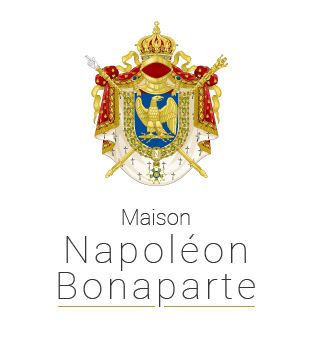FR | EN
Values sown in all the minds of the world.
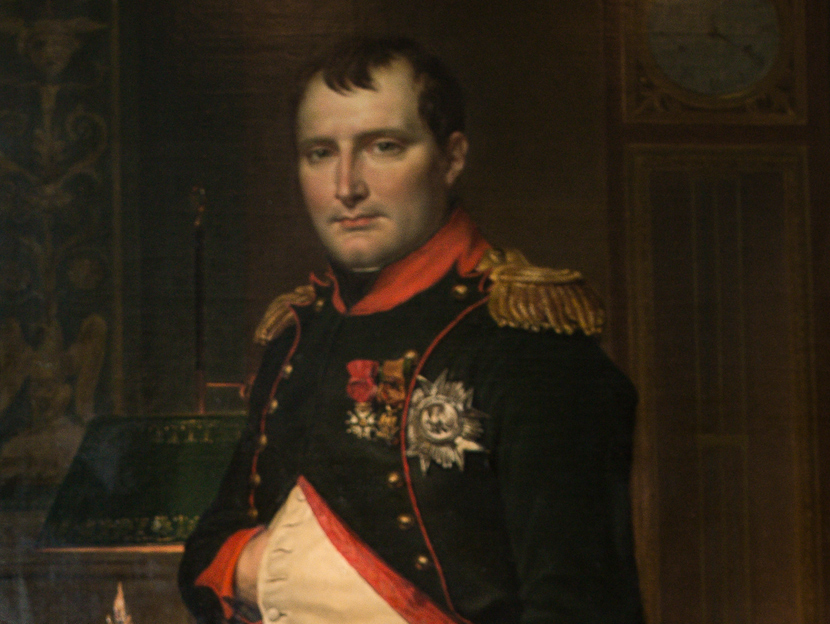

Napoleon I, ferryman of worlds
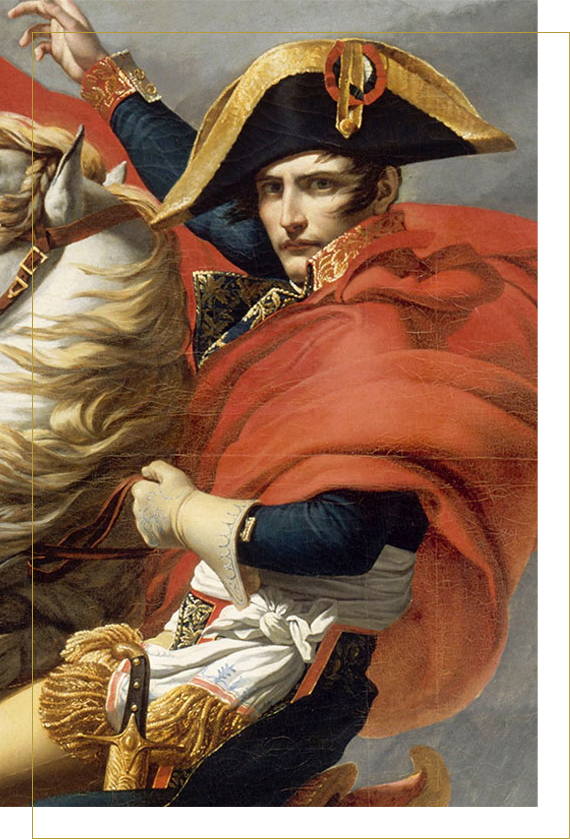
Napoleon Bonaparte was born on 15 August 1769 in Ajaccio and died on 5 May 1821 on the island of Saint Helena. A shooting star in history, he had an extraordinary and unprecedented destiny: that of the son of a small Corsican noble family who became a general, First Consul, Emperor and then Master of Europe at the age of only 35, and who ended his life in isolation on the rock of Saint Helena. He inaugurated the image of the modern ‘self-made man’. His life was, for many, a sign that anything is possible.
In addition to being an exceptional statesman, Napoleon was also the passionate lover of his first wife Josephine, the attentive husband of Marie-Louise, the doting father of the King of Rome and the patriarch of a large group of siblings to whom he always remained loyal.
Unanimously recognised as one of the most important figures in the history of France and Europe, Napoleon wished to establish a synthesis between the changes brought about by the modern ideas of the French Revolution and the perpetuation of certain traditions, symbolised by the monarchical power at the time. “I have become the ark of the covenant between the old and the new”, he said on St Helena.
Napoleon created the institutional, legal, administrative, economic, educational, cultural and architectural foundations of contemporary France. Our democracy today is based on his contributions, from the codification of the rule of law and equality to the promotion of meritocracy. Napoleon’s influence also extended to many European countries which have used the Napoleonic Code as their legal basis.
As a joint mark of his respect for the past, Napoleon was able to unify customs and laws from the Ancien Régime in the Code that bears his name. Among other things, he had Turenne’s tomb transferred to the Invalides, but also adopted the golden bees of the Merovingians as symbols of the Empire. Napoleon also ensured that the Catholic Church retained its place in the country with the Concordat.
Napoleon also embodies military genius, his conquests being among the greatest in French history. He protected his country from the coalitions of European kingdoms hostile to the ideas of the French Revolution. After winning 57 victories, his saga ended definitively against the 7th coalition at the Battle of Waterloo.
Napoleon is a character who arouses both positive and negative passions. He undeniably made mistakes, including the reintroduction of slavery in the French colonies. The geopolitical motivations for this action, which was taken after much resistance (“You don’t take freedom away from a people to whom you have granted it”), do not justify it in any way. However, the legacy and contributions of this man cannot be reduced to this decision alone. Napoleon eventually abolished the slave trade in 1815.
As far as the status of women is concerned, it should be remembered that the Convention had put an end to the demands of the women’s clubs, which it had closed. By enacting a hierarchy of the family that was largely unfavourable to women, the Civil Code reflected a society that was objectively dominated by men, which remained so for a long time and is still sometimes the case today despite progress in law and mentalities.
Napoleon was a visionary whose contributions are still important today in many areas (high schools, universities, the baccalaureate, the Conseil des Prudhommes, prefects, the Cour des Comptes, the Banque de France, facilitating the integration of the Jewish people into the Empire, etc.). His legend has given rise to a great deal of historical and biographical writing, as well as novels and films. Today, there are more books devoted to Napoleon than days that have passed since his death.
The contributions of Napoleon I
1799 The Council of State
1799 The Senate
1800 The Bank of France
1800 The prefectural corps
1801 The Concordat
1802 The Legion of Honour
1802 The Republican Guard
1802 The lycées (high schools)
1802 The Saint-Cyr military school
1802 The Chambers of Commerce
1803 The Germinal Franc
1804 The Civil Code (Napoleonic Code abroad)
1804 The military status of the École Polytechnique
1806 The first Conseil des Prud’hommes
1806 The modern university
1807 The Paris Stock Exchange
1807 The Great Sanhedrin (assimilation of the Jews)
1807 The Court of Auditors
1808 The Baccalaureate
1810 The Penal Code
1811 The Paris fire brigade.
The face of Paris:
The Arc de Triomphe of the Étoile
The Arc de Triomphe of the Carrousel du Louvre
The Vendôme column
The Brogniart Palace (Paris Stock Exchange)
The Madeleine church
The odd-even numbering of the streets of the capital
The opening of the Rue de Rivoli, Rue de la Paix, Rue de Castiglione, Rue des Pyramides and Rue d’Ulm
The new façade of the Palais Bourbon
The transformation of the Louvre into a museum
The link between the Louvre and the Tuileries Palace
Completion of the Cour Carrée of the Louvre (construction of the West and South wings)
The installation of the headquarters of the Institut de France (the Academies) on the Quai Conti
The consolidation of the Pantheon
Construction of the Palais d’Orsay
The construction of 3 bridges: the Pont des Arts (1803), Austerlitz and Iéna
The digging of the Ourcq, Saint-Martin and Saint-Denis canals
The construction of about fifteen fountains, including the Elephant of the Bastille
The development of the Père Lachaise cemetery
The development of numerous green spaces, such as the Jardin des Plantes
The embellishment of the Luxembourg Gardens.
In the provinces and abroad:
The Napoleonic Code (still used as a legal basis in many European countries)
The foundation of Napoleon-Vendée (today’s La Roche-sur-Yon)
The transformation of the Place Bellecour in Lyon
The stone bridge in Bordeaux
Construction of Fort Napoleon in La Seyne-sur-Mer
La construction du Fort Napoléon à La Seyne-sur-Mer
The Nantes-Brest and Mons-Condé canals.
Napoleon III, the economic and social Empire
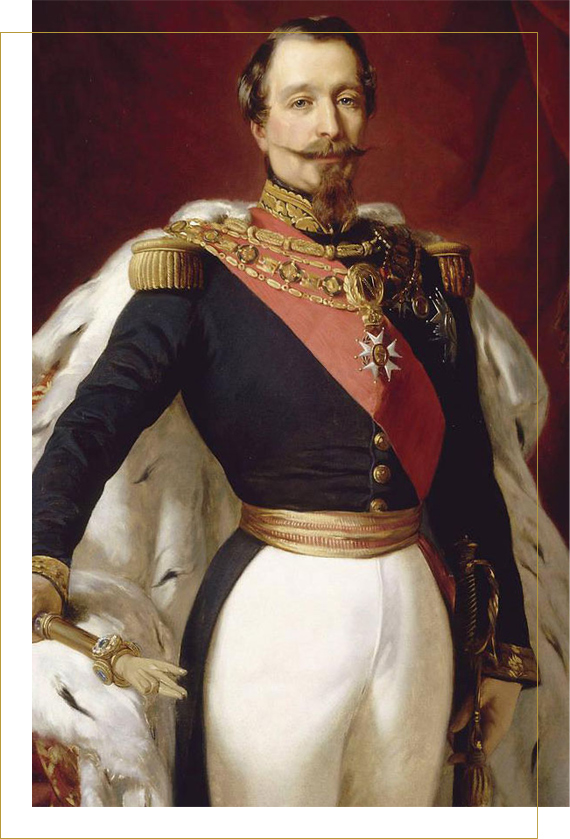
Both the first president of the French Republic and the last monarch of our country, Napoleon III brought France into the industrial age and laid the foundations of an innovative social policy. His reforms led to a rapid expansion of the French economy and industrialisation, which was then lagging behind its English and German neighbours.
Louis-Napoleon Bonaparte was born on 20 April 1808 in Paris. The son of Louis Bonaparte, King of Holland, and Hortense de Beauharnais, he was the nephew of Emperor Napoleon I and the grandson of Empress Josephine de Beauharnais. He became the heir apparent to the imperial throne following the successive deaths of his elder brother Napoleon-Louis in 1831, and his cousin the Duke of Reichstadt (Napoleon II, King of Rome) in 1832. After attempting to rouse the Strasbourg regiment in 1836, and then the soldiers stationed at Boulogne-sur-Mer in 1840, he was imprisoned in the fort of Ham, where he wrote a book on the struggle against poverty, before managing to escape in 1846.
In 1848, the fall of the July Monarchy allowed Louis-Napoleon Bonaparte to stand for election and become the first French head of state elected by universal male suffrage on 10 December 1848. On 2 December 1851, his coup was approved by a plebiscite. A year later, on 21 and 22 November 1852, the Prince-President asked the French people in a plebiscite if they would accept the return of the imperial regime, and on 2 December 1852 he became Emperor Napoleon III.
On 29 January 1853, the civil marriage of Napoleon III to Eugenie de Montijo was celebrated in the Tuileries, and on 30 January, the religious marriage took place in Notre Dame. Louis Napoleon, the only son of Napoleon III and Empress Eugénie, was born on 16 March 1856.
INFRASTRUCTURE
The Second Empire was the first French regime to focus on economic objectives. In order to improve the movement of people and goods, Napoleon III created six major railway companies, increased the length of the railways fivefold, enlarged the ports of Le Havre, Bordeaux and Marseille and created the port of Saint-Nazaire. He also increased the number of roads and waterways and connected the major cities with the telegraph. Finally, he allowed the enlargement of the territory of France with the attachment of the county of Nice and Savoy in 1860 at the time of the Italian unification.
SOCIAL POLICY
Napoleon III was always sensitive to social suffering. He wanted to improve the well-being of those who contributed directly to the country’s industrial development. Napoleon III thus authorised the right to strike, encouraged the creation of the first mutual insurance companies and trade union chambers, but also improved housing.
MAJOR WORKS
At the request of Napoleon III, the capital was redeveloped and embellished under the direction of Baron Hausmann, Prefect of the Seine from 1853 to 1870. A gas lighting system, a drinking water supply network and sewers were installed. Wide avenues were also built through the old districts. The Halles were built in the centre of the city.
THE BANKING SYSTEM
The French banking system underwent a remarkable development during the Second Empire. Napoleon III encouraged the creation of large banks that invested their funds in industry and commerce. These included the Crédit Industriel et Commercial (1859), the Crédit Lyonnais (1863) and the Société Générale (1864).
Following the defeat at the Battle of Sedan in 1870, Napoleon III went into exile in England with the Empress Eugenie and their only son, the Imperial Prince. He died on 9 January 1873 and is still buried today at St Michael’s Abbey in Farnborough, founded in 1881 by Empress Eugenie, next to the Imperial Prince (who died in 1879) and his wife (who died in 1920).
Napoleon III’s contributions
Social rights:
The right to strike
First mutual societies
Trade union chambers
First industrial tribunal
Infrastructure::
Development of railway lines
Expansion of the ports of Le Havre, Bordeaux and Marseille
Creation of Saint-Nazaire
Development of waterways
Expansion of the telegraph
The face of Paris:
Haussmannian buildings
Completion of the Louvre, and the northern link between the Louvre and the Tuileries Palace
The construction of the Paris Opera House, and numerous theatres
The creation of squares and large parks, in particular the Bois de Boulogne
The launch of the first social housing for workers
The widespread use of gas lighting
The construction of 600 kilometres of sewers
The decongestion of Paris by creating a crossroads of two axes, west-east with Rivoli-Bastille, and north-south with the Boulevard de Sébastopol
Spa and seaside resorts:
Deauville
Monte-Carlo
Biarritz
Vichy
The banking system:
Le Crédit Industriel et Commercial
Le Crédit Lyonnais
La Société Générale
Louis Napoleon Bonaparte, in the service of France
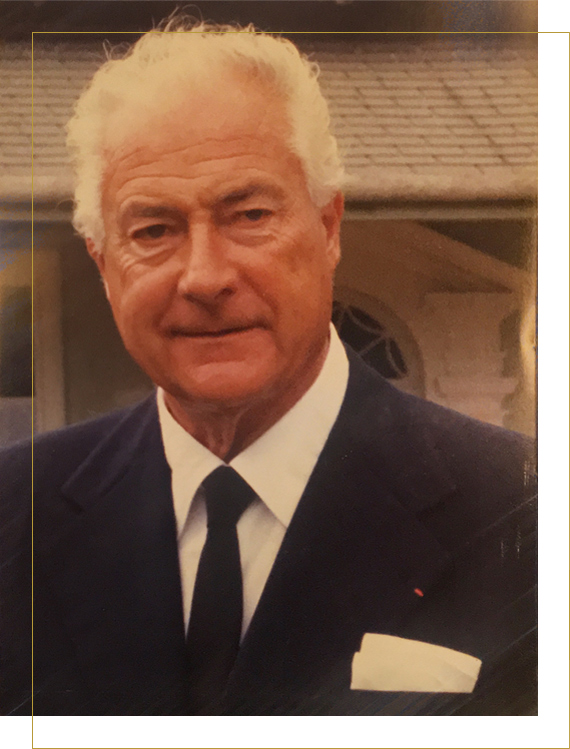
Prince Louis Napoleon Bonaparte was born on 23 January 1914 in Brussels and died on 3 May 1997 in Genolier, Switzerland. Great-grandson of Jerome Bonaparte, King of Westphalia, brother of Napoleon I, he was the Head of the Imperial House of France from 1926 until his death, bearing the title of Prince Napoleon, and being considered by Bonapartists as ‘Napoleon VI’.
Born in exile because of the exile law of 1886, which struck at the heads of the former ruling families (Bonaparte and Orléans), he spent his youth in England and Belgium, before moving to Switzerland.
In 1939, he wanted to join the French army to defend his country, but the President of the Council, Edouard Daladier, refused his request. Louis Napoleon Bonaparte then joined the Foreign Legion under the assumed name of Louis Blanchard. On 3 April 1940, Legionnaire Blanchard was assigned to the company stationed at Saïda in Algeria. The end of the fighting in France came too soon for his unit to be engaged.
Prince Napoleon then joined the Resistance. Arrested in 1942 while trying to join Free France through Spain, he refused the proposals made to him by the Germans and asked to be deported to Germany or released without conditions or concessions. Among other things, he refused to support the repatriation of the ashes of the King of Rome (son of Napoleon I) from Vienna to France at Les Invalides, orchestrated by Hitler to improve his image in the eyes of the French. Placed under house arrest, he fled and joined the Resistance (ORA) under the pseudonym of Louis Monnier, participating in several operations.
On 28 August 1944, he was wounded by German gunfire. Mentioned in the army order, decorated with the Legion of Honour as a soldier, congratulated by General De Gaulle, he was demobilised after the victory. His attitude during the Second World War certainly contributed to the abolition, on 24 June 1950, of the law of exile which affected the Bonapartes.
In 1949, Prince Louis Napoleon Bonaparte married Alix de Foresta, daughter of the Count and Countess de Foresta. The couple had four children: Charles, Catherine, Laure, and Jérôme. An avid skier, car racer and scuba diver, Prince Napoleon was involved in companies operating in the Sahara, Equatorial Africa and the former Belgian Congo.
In 1979, Prince Louis Napoleon Bonaparte made a historic donation to the State of manuscripts, souvenirs, paintings, sculptures, swords, silverware, official clothes, and objects of the Emperors, from the estate of Napoleon I and Napoleon III, through Empress Eugenie and her father Victor. Far from any partisan considerations, Prince Napoleon considered it his duty to put his family’s heritage at the service of the Nation as he had done with his own person.
Driven by a high awareness of his historical mission, he wished to keep alive among his compatriots the memory of the two Empires of which he was the heir. What his ancestors had left him as an inheritance was for him a sacred legacy for which he was accountable and which was part of the glories of France.
Prince Napoleon now rests in the family crypt of the imperial chapel in Ajaccio. In his dynastic will, he named his grandson Jean-Christophe (not his eldest son Charles) as the new pretender to the French imperial throne, head of the Imperial House of France, and Prince Napoleon.
FR | EN
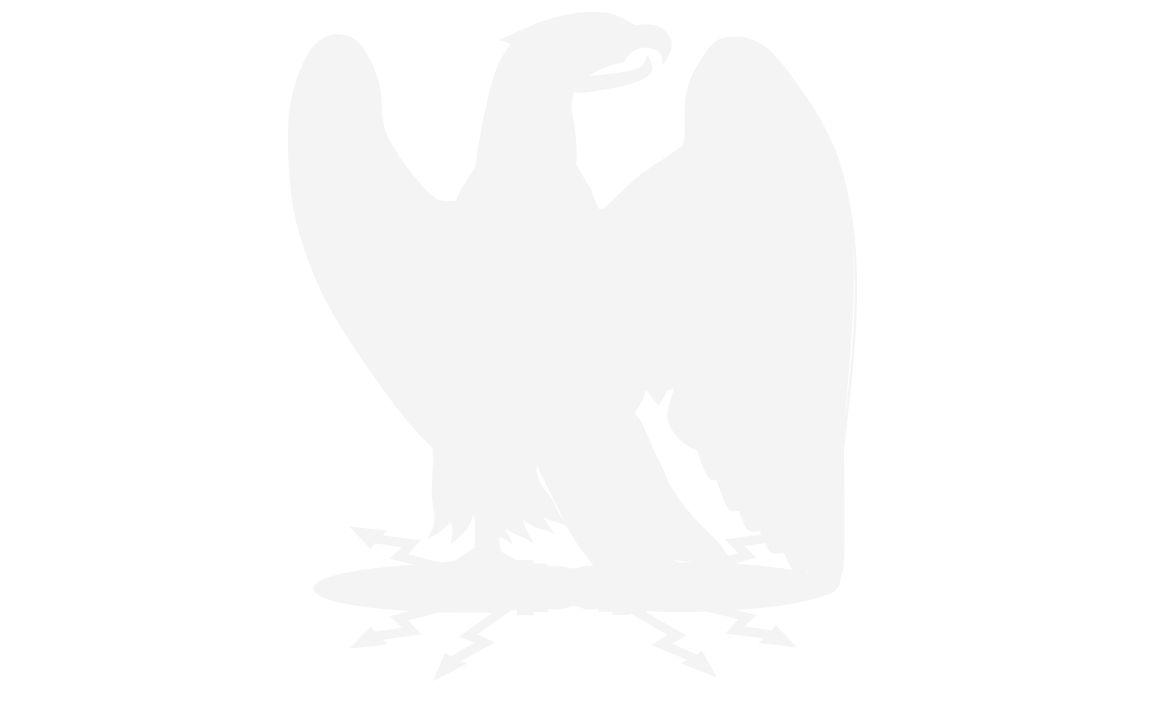
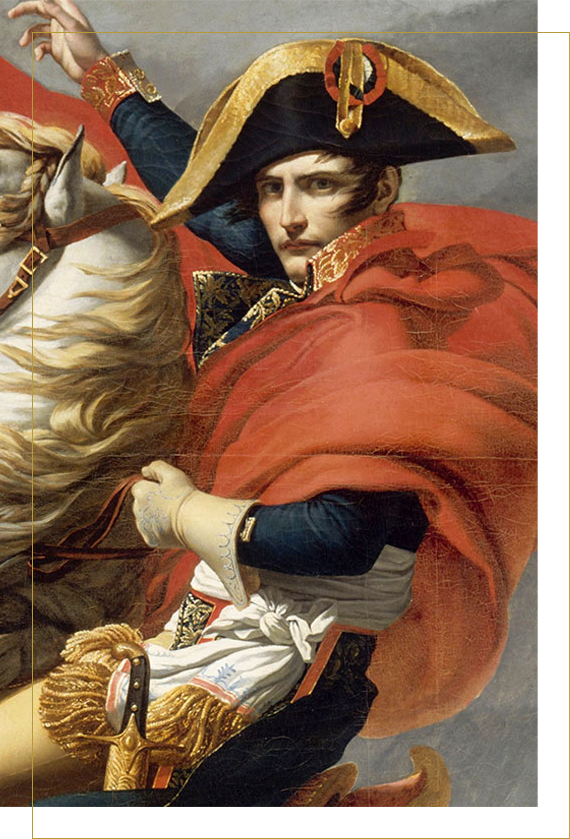
The contributions of Napoleon I
1799 The Council of State
1799 The Senate
1800 The Bank of France
1800 The prefectural corps
1801 The Concordat
1802 The Legion of Honour
1802 The Republican Guard
1802 The lycées (high schools)
1802 The Saint-Cyr military school
1802 The Chambers of Commerce
1803 The Germinal Franc
1804 The Civil Code (Napoleonic Code abroad)
1804 The military status of the École Polytechnique
1806 The first Conseil des Prud’hommes
1806 The modern university
1807 The Paris Stock Exchange
1807 The Great Sanhedrin (assimilation of the Jews)
1807 The Court of Auditors
1808 The Baccalaureate
1810 The Penal Code
1811 The Paris fire brigade.
The face of Paris:
The Arc de Triomphe of the Étoile
The Arc de Triomphe of the Carrousel du Louvre
The Vendôme column
The Brogniart Palace (Paris Stock Exchange)
The Madeleine church
The odd-even numbering of the streets of the capital
The opening of the Rue de Rivoli, Rue de la Paix, Rue de Castiglione, Rue des Pyramides and Rue d’Ulm
The new façade of the Palais Bourbon
The transformation of the Louvre into a museum
The link between the Louvre and the Tuileries Palace
Completion of the Cour Carrée of the Louvre (construction of the West and South wings)
The installation of the headquarters of the Institut de France (the Academies) on the Quai Conti
The consolidation of the Pantheon
Construction of the Palais d’Orsay
The construction of 3 bridges: the Pont des Arts (1803), Austerlitz and Iéna
The digging of the Ourcq, Saint-Martin and Saint-Denis canals
The construction of about fifteen fountains, including the Elephant of the Bastille
The development of the Père Lachaise cemetery
The development of numerous green spaces, such as the Jardin des Plantes
The embellishment of the Luxembourg Gardens.
In the provinces and abroad:
The Napoleonic Code
(still used as a legal basis in many European countries)
The foundation of Napoleon-Vendée (today’s La Roche-sur-Yon)
The transformation of the Place Bellecour in Lyon
The stone bridge in Bordeaux
The construction of the Place de la Paix in Milan
Construction of Fort Napoleon in La Seyne-sur-Mer
The Nantes-Brest and Mons-Condé canals.
Napoleon I, ferryman of worlds
Napoleon Bonaparte was born on 15 August 1769 in Ajaccio and died on 5 May 1821 on the island of Saint Helena. A shooting star in history, he had an extraordinary and unprecedented destiny: that of the son of a small Corsican noble family who became a general, First Consul, Emperor and then Master of Europe at the age of only 35, and who ended his life in isolation on the rock of Saint Helena. He inaugurated the image of the modern ‘self-made man’. His life was, for many, a sign that anything is possible.
In addition to being an exceptional statesman, Napoleon was also the passionate lover of his first wife Josephine, the attentive husband of Marie-Louise, the doting father of the King of Rome and the patriarch of a large group of siblings to whom he always remained loyal.
Unanimously recognised as one of the most important figures in the history of France and Europe, Napoleon wished to establish a synthesis between the changes brought about by the modern ideas of the French Revolution and the perpetuation of certain traditions, symbolised by the monarchical power at the time. “I have become the ark of the covenant between the old and the new”, he said on St Helena.
Napoleon created the institutional, legal, administrative, economic, educational, cultural and architectural foundations of contemporary France. Our democracy today is based on his contributions, from the codification of the rule of law and equality to the promotion of meritocracy. Napoleon’s influence also extended to many European countries which have used the Napoleonic Code as their legal basis.
As a joint mark of his respect for the past, Napoleon was able to unify customs and laws from the Ancien Régime in the Code that bears his name. Among other things, he had Turenne’s tomb transferred to the Invalides, but also adopted the golden bees of the Merovingians as symbols of the Empire. Napoleon also ensured that the Catholic Church retained its place in the country with the Concordat.
Napoleon also embodies military genius, his conquests being among the greatest in French history. He protected his country from the coalitions of European kingdoms hostile to the ideas of the French Revolution. After winning 57 victories, his saga ended definitively against the 7th coalition at the Battle of Waterloo.
Napoleon is a character who arouses both positive and negative passions. He undeniably made mistakes, including the reintroduction of slavery in the French colonies. The geopolitical motivations for this action, which was taken after much resistance (“You don’t take freedom away from a people to whom you have granted it”), do not justify it in any way. However, the legacy and contributions of this man cannot be reduced to this decision alone. Napoleon eventually abolished the slave trade in 1815.
As far as the status of women is concerned, it should be remembered that the Convention had put an end to the demands of the women’s clubs, which it had closed. By enacting a hierarchy of the family that was largely unfavourable to women, the Civil Code reflected a society that was objectively dominated by men, which remained so for a long time and is still sometimes the case today despite progress in law and mentalities.
Napoleon was a visionary whose contributions are still important today in many areas (high schools, universities, the baccalaureate, the Conseil des Prudhommes, prefects, the Cour des Comptes, the Banque de France, facilitating the integration of the Jewish people into the Empire, etc.). His legend has given rise to a great deal of historical and biographical writing, as well as novels and films. Today, there are more books devoted to Napoleon than days that have passed since his death.
Napoleon III, the economic and social Empire
Both the first president of the French Republic and the last monarch of our country, Napoleon III brought France into the industrial age and laid the foundations of an innovative social policy. His reforms led to a rapid expansion of the French economy and industrialisation, which was then lagging behind its English and German neighbours.
Louis-Napoleon Bonaparte was born on 20 April 1808 in Paris. The son of Louis Bonaparte, King of Holland, and Hortense de Beauharnais, he was the nephew of Emperor Napoleon I and the grandson of Empress Josephine de Beauharnais. He became the heir apparent to the imperial throne following the successive deaths of his elder brother Napoleon-Louis in 1831, and his cousin the Duke of Reichstadt (Napoleon II, King of Rome) in 1832. After attempting to rouse the Strasbourg regiment in 1836, and then the soldiers stationed at Boulogne-sur-Mer in 1840, he was imprisoned in the fort of Ham, where he wrote a book on the struggle against poverty, before managing to escape in 1846.
In 1848, the fall of the July Monarchy allowed Louis-Napoleon Bonaparte to stand for election and become the first French head of state elected by universal male suffrage on 10 December 1848. On 2 December 1851, his coup was approved by a plebiscite. A year later, on 21 and 22 November 1852, the Prince-President asked the French people in a plebiscite if they would accept the return of the imperial regime, and on 2 December 1852 he became Emperor Napoleon III.
On 29 January 1853, the civil marriage of Napoleon III to Eugenie de Montijo was celebrated in the Tuileries, and on 30 January, the religious marriage took place in Notre Dame. Louis Napoleon, the only son of Napoleon III and Empress Eugénie, was born on 16 March 1856.
INFRASTRUCTURE
The Second Empire was the first French regime to focus on economic objectives. In order to improve the movement of people and goods, Napoleon III created six major railway companies, increased the length of the railways fivefold, enlarged the ports of Le Havre, Bordeaux and Marseille and created the port of Saint-Nazaire. He also increased the number of roads and waterways and connected the major cities with the telegraph. Finally, he allowed the enlargement of the territory of France with the attachment of the county of Nice and Savoy in 1860 at the time of the Italian unification.
SOCIAL POLICY
Napoleon III was always sensitive to social suffering. He wanted to improve the well-being of those who contributed directly to the country’s industrial development. Napoleon III thus authorised the right to strike, encouraged the creation of the first mutual insurance companies and trade union chambers, but also improved housing.
MAJOR WORKS
At the request of Napoleon III, the capital was redeveloped and embellished under the direction of Baron Hausmann, Prefect of the Seine from 1853 to 1870. A gas lighting system, a drinking water supply network and sewers were installed. Wide avenues were also built through the old districts. The Halles were built in the centre of the city.
THE BANKING SYSTEM
The French banking system underwent a remarkable development during the Second Empire. Napoleon III encouraged the creation of large banks that invested their funds in industry and commerce. These included the Crédit Industriel et Commercial (1859), the Crédit Lyonnais (1863) and the Société Générale (1864).
Following the defeat at the Battle of Sedan in 1870, Napoleon III went into exile in England with the Empress Eugenie and their only son, the Imperial Prince. He died on 9 January 1873 and is still buried today at St Michael’s Abbey in Farnborough, founded in 1881 by Empress Eugenie, next to the Imperial Prince (who died in 1879) and his wife (who died in 1920).

Napoleon III’s contributions
Social rights:
The right to strike
First mutual societies
Trade union chambers
First industrial tribunal
Infrastructure:
Development of railway lines
Expansion of the ports of Le Havre, Bordeaux and Marseille
Creation of Saint-Nazaire
Development of waterways
Expansion of the telegraph
The face of Paris:
Haussmannian buildings
Completion of the Louvre, and the northern link between the Louvre and the Tuileries Palace
The construction of the Paris Opera House, and numerous theatres
The creation of squares and large parks, in particular the Bois de Boulogne
The launch of the first social housing for workers
The widespread use of gas lighting
The construction of 600 kilometres of sewers
The decongestion of Paris by creating a crossroads of two axes, west-east with Rivoli-Bastille, and north-south with the Boulevard de Sébastopol
Spa and seaside resort:
Deauville
Monte-Carlo
Biarritz
Vichy
The banking system:
Le Crédit Industriel et Commercial
Le Crédit Lyonnais
La Société Générale

Louis Napoleon Bonaparte, in the service of France
Prince Louis Napoleon Bonaparte was born on 23 January 1914 in Brussels and died on 3 May 1997 in Genolier, Switzerland. Great-grandson of Jerome Bonaparte, King of Westphalia, brother of Napoleon I, he was the Head of the Imperial House of France from 1926 until his death, bearing the title of Prince Napoleon, and being considered by Bonapartists as ‘Napoleon VI’.
Born in exile because of the exile law of 1886, which struck at the heads of the former ruling families (Bonaparte and Orléans), he spent his youth in England and Belgium, before moving to Switzerland.
In 1939, he wanted to join the French army to defend his country, but the President of the Council, Edouard Daladier, refused his request. Louis Napoleon Bonaparte then joined the Foreign Legion under the assumed name of Louis Blanchard. On 3 April 1940, Legionnaire Blanchard was assigned to the company stationed at Saïda in Algeria. The end of the fighting in France came too soon for his unit to be engaged.
Prince Napoleon then joined the Resistance. Arrested in 1942 while trying to join Free France through Spain, he refused the proposals made to him by the Germans and asked to be deported to Germany or released without conditions or concessions. Among other things, he refused to support the repatriation of the ashes of the King of Rome (son of Napoleon I) from Vienna to France at Les Invalides, orchestrated by Hitler to improve his image in the eyes of the French. Placed under house arrest, he fled and joined the Resistance (ORA) under the pseudonym of Louis Monnier, participating in several operations.
On 28 August 1944, he was wounded by German gunfire. Mentioned in the army order, decorated with the Legion of Honour as a soldier, congratulated by General De Gaulle, he was demobilised after the victory. His attitude during the Second World War certainly contributed to the abolition, on 24 June 1950, of the law of exile which affected the Bonapartes.
In 1949, Prince Louis Napoleon Bonaparte married Alix de Foresta, daughter of the Count and Countess de Foresta. The couple had four children: Charles, Catherine, Laure, and Jérôme. An avid skier, car racer and scuba diver, Prince Napoleon was involved in companies operating in the Sahara, Equatorial Africa and the former Belgian Congo.
In 1979, Prince Louis Napoleon Bonaparte made a historic donation to the State of manuscripts, souvenirs, paintings, sculptures, swords, silverware, official clothes, and objects of the Emperors, from the estate of Napoleon I and Napoleon III, through Empress Eugenie and her father Victor. Far from any partisan considerations, Prince Napoleon considered it his duty to put his family’s heritage at the service of the Nation as he had done with his own person.
Driven by a high awareness of his historical mission, he wished to keep alive among his compatriots the memory of the two Empires of which he was the heir. What his ancestors had left him as an inheritance was for him a sacred legacy for which he was accountable and which was part of the glories of France.
Prince Napoleon now rests in the family crypt of the imperial chapel in Ajaccio. In his dynastic will, he named his grandson Jean-Christophe (not his eldest son Charles) as the new pretender to the French imperial throne, head of the Imperial House of France, and Prince Napoleon.
FR | EN

HOME > THE HISTORY

Napoleon I, ferryman of worlds
Napoleon Bonaparte was born on 15 August 1769 in Ajaccio and died on 5 May 1821 on the island of Saint Helena. A shooting star in history, he had an extraordinary and unprecedented destiny: that of the son of a small Corsican noble family who became a general, First Consul, Emperor and then Master of Europe at the age of only 35, and who ended his life in isolation on the rock of Saint Helena. He inaugurated the image of the modern ‘self-made man’. His life was, for many, a sign that anything is possible.
In addition to being an exceptional statesman, Napoleon was also the passionate lover of his first wife Josephine, the attentive husband of Marie-Louise, the doting father of the King of Rome and the patriarch of a large group of siblings to whom he always remained loyal.
Unanimously recognised as one of the most important figures in the history of France and Europe, Napoleon wished to establish a synthesis between the changes brought about by the modern ideas of the French Revolution and the perpetuation of certain traditions, symbolised by the monarchical power at the time. “I have become the ark of the covenant between the old and the new”, he said on St Helena.
Napoleon created the institutional, legal, administrative, economic, educational, cultural and architectural foundations of contemporary France. Our democracy today is based on his contributions, from the codification of the rule of law and equality to the promotion of meritocracy. Napoleon’s influence also extended to many European countries which have used the Napoleonic Code as their legal basis.
As a joint mark of his respect for the past, Napoleon was able to unify customs and laws from the Ancien Régime in the Code that bears his name. Among other things, he had Turenne’s tomb transferred to the Invalides, but also adopted the golden bees of the Merovingians as symbols of the Empire. Napoleon also ensured that the Catholic Church retained its place in the country with the Concordat.
Napoleon also embodies military genius, his conquests being among the greatest in French history. He protected his country from the coalitions of European kingdoms hostile to the ideas of the French Revolution. After winning 57 victories, his saga ended definitively against the 7th coalition at the Battle of Waterloo.
Napoleon is a character who arouses both positive and negative passions. He undeniably made mistakes, including the reintroduction of slavery in the French colonies. The geopolitical motivations for this action, which was taken after much resistance (“You don’t take freedom away from a people to whom you have granted it”), do not justify it in any way. However, the legacy and contributions of this man cannot be reduced to this decision alone. Napoleon eventually abolished the slave trade in 1815.
As far as the status of women is concerned, it should be remembered that the Convention had put an end to the demands of the women’s clubs, which it had closed. By enacting a hierarchy of the family that was largely unfavourable to women, the Civil Code reflected a society that was objectively dominated by men, which remained so for a long time and is still sometimes the case today despite progress in law and mentalities.
Napoleon was a visionary whose contributions are still important today in many areas (high schools, universities, the baccalaureate, the Conseil des Prudhommes, prefects, the Cour des Comptes, the Banque de France, facilitating the integration of the Jewish people into the Empire, etc.). His legend has given rise to a great deal of historical and biographical writing, as well as novels and films. Today, there are more books devoted to Napoleon than days that have passed since his death.

The contributions of Napoleon I
1799 The Council of State
1799 The Senate
1800 The Bank of France
1800 The prefectural corps
1801 The Concordat
1802 The Legion of Honour
1802 The Republican Guard
1802 The lycées (high schools)
1802 The Saint-Cyr military school
1802 The Chambers of Commerce
1803 The Germinal Franc
1804 The Civil Code (Napoleonic Code abroad)
1804 The military status of the École Polytechnique
1806 The first Conseil des Prud’hommes
1806 The modern university
1807 The Paris Stock Exchange
1807 The Great Sanhedrin (assimilation of the Jews)
1807 The Court of Auditors
1808 The Baccalaureate
1810 The Penal Code
1811 The Paris fire brigade.
The face of Paris:
The Arc de Triomphe of the Étoile
The Arc de Triomphe of the Carrousel du Louvre
The Vendôme column
The Brogniart Palace (Paris Stock Exchange)
The Madeleine church
The odd-even numbering of the streets of the capital
The opening of the Rue de Rivoli, Rue de la Paix, Rue de Castiglione, Rue des Pyramides and Rue d’Ulm
The new façade of the Palais Bourbon
The transformation of the Louvre into a museum
The link between the Louvre and the Tuileries Palace
Completion of the Cour Carrée of the Louvre (construction of the West and South wings)
The installation of the headquarters of the Institut de France (the Academies) on the Quai Conti
The consolidation of the Pantheon
Construction of the Palais d’Orsay
The construction of 3 bridges: the Pont des Arts (1803), Austerlitz and Iéna
The digging of the Ourcq, Saint-Martin and Saint-Denis canals
The construction of about fifteen fountains, including the Elephant of the Bastille
The development of the Père Lachaise cemetery
The development of numerous green spaces, such as the Jardin des Plantes
The embellishment of the Luxembourg Gardens.
In the provinces and abroad:
The Napoleonic Code
(still used as a legal basis in many European countries)
The foundation of Napoleon-Vendée (today’s La Roche-sur-Yon)
The transformation of the Place Bellecour in Lyon
The stone bridge in Bordeaux
The construction of the Place de la Paix in Milan
Construction of Fort Napoleon in La Seyne-sur-Mer
The Nantes-Brest and Mons-Condé canals.
Napoleon III, the economic and social Empire
Both the first president of the French Republic and the last monarch of our country, Napoleon III brought France into the industrial age and laid the foundations of an innovative social policy. His reforms led to a rapid expansion of the French economy and industrialisation, which was then lagging behind its English and German neighbours.
Louis-Napoleon Bonaparte was born on 20 April 1808 in Paris. The son of Louis Bonaparte, King of Holland, and Hortense de Beauharnais, he was the nephew of Emperor Napoleon I and the grandson of Empress Josephine de Beauharnais. He became the heir apparent to the imperial throne following the successive deaths of his elder brother Napoleon-Louis in 1831, and his cousin the Duke of Reichstadt (Napoleon II, King of Rome) in 1832. After attempting to rouse the Strasbourg regiment in 1836, and then the soldiers stationed at Boulogne-sur-Mer in 1840, he was imprisoned in the fort of Ham, where he wrote a book on the struggle against poverty, before managing to escape in 1846.
In 1848, the fall of the July Monarchy allowed Louis-Napoleon Bonaparte to stand for election and become the first French head of state elected by universal male suffrage on 10 December 1848. On 2 December 1851, his coup was approved by a plebiscite. A year later, on 21 and 22 November 1852, the Prince-President asked the French people in a plebiscite if they would accept the return of the imperial regime, and on 2 December 1852 he became Emperor Napoleon III.
On 29 January 1853, the civil marriage of Napoleon III to Eugenie de Montijo was celebrated in the Tuileries, and on 30 January, the religious marriage took place in Notre Dame. Louis Napoleon, the only son of Napoleon III and Empress Eugénie, was born on 16 March 1856.
INFRASTRUCTURE
The Second Empire was the first French regime to focus on economic objectives. In order to improve the movement of people and goods, Napoleon III created six major railway companies, increased the length of the railways fivefold, enlarged the ports of Le Havre, Bordeaux and Marseille and created the port of Saint-Nazaire. He also increased the number of roads and waterways and connected the major cities with the telegraph. Finally, he allowed the enlargement of the territory of France with the attachment of the county of Nice and Savoy in 1860 at the time of the Italian unification.
SOCIAL POLICY
Napoleon III was always sensitive to social suffering. He wanted to improve the well-being of those who contributed directly to the country’s industrial development. Napoleon III thus authorised the right to strike, encouraged the creation of the first mutual insurance companies and trade union chambers, but also improved housing.
MAJOR WORKS
At the request of Napoleon III, the capital was redeveloped and embellished under the direction of Baron Hausmann, Prefect of the Seine from 1853 to 1870. A gas lighting system, a drinking water supply network and sewers were installed. Wide avenues were also built through the old districts. The Halles were built in the centre of the city.
THE BANKING SYSTEM
The French banking system underwent a remarkable development during the Second Empire. Napoleon III encouraged the creation of large banks that invested their funds in industry and commerce. These included the Crédit Industriel et Commercial (1859), the Crédit Lyonnais (1863) and the Société Générale (1864).
Following the defeat at the Battle of Sedan in 1870, Napoleon III went into exile in England with the Empress Eugenie and their only son, the Imperial Prince. He died on 9 January 1873 and is still buried today at St Michael’s Abbey in Farnborough, founded in 1881 by Empress Eugenie, next to the Imperial Prince (who died in 1879) and his wife (who died in 1920).

Napoleon III’s contributions
Social rights:
The right to strike
First mutual societies
Trade union chambers
First industrial tribunal
Infrastructure:
Development of railway lines
Expansion of the ports of Le Havre, Bordeaux and Marseille
Creation of Saint-Nazaire
Development of waterways
Expansion of the telegraph
The face of Paris:
Haussmannian buildings
Completion of the Louvre, and the northern link between the Louvre and the Tuileries Palace
The construction of the Paris Opera House, and numerous theatres
The creation of squares and large parks, in particular the Bois de Boulogne
The launch of the first social housing for workers
The widespread use of gas lighting
The construction of 600 kilometres of sewers
The decongestion of Paris by creating a crossroads of two axes, west-east with Rivoli-Bastille, and north-south with the Boulevard de Sébastopol
Spa and seaside resorts:
Deauville
Monte-Carlo
Biarritz
Vichy
The banking system:
Le Crédit Industriel et Commercial
Le Crédit Lyonnais
La Société Générale
Louis Napoleon Bonaparte,
in the service of France
Prince Louis Napoleon Bonaparte was born on 23 January 1914 in Brussels and died on 3 May 1997 in Genolier, Switzerland. Great-grandson of Jerome Bonaparte, King of Westphalia, brother of Napoleon I, he was the Head of the Imperial House of France from 1926 until his death, bearing the title of Prince Napoleon, and being considered by Bonapartists as ‘Napoleon VI’.
Born in exile because of the exile law of 1886, which struck at the heads of the former ruling families (Bonaparte and Orléans), he spent his youth in England and Belgium, before moving to Switzerland.
In 1939, he wanted to join the French army to defend his country, but the President of the Council, Edouard Daladier, refused his request. Louis Napoleon Bonaparte then joined the Foreign Legion under the assumed name of Louis Blanchard. On 3 April 1940, Legionnaire Blanchard was assigned to the company stationed at Saïda in Algeria. The end of the fighting in France came too soon for his unit to be engaged.
Prince Napoleon then joined the Resistance. Arrested in 1942 while trying to join Free France through Spain, he refused the proposals made to him by the Germans and asked to be deported to Germany or released without conditions or concessions. Among other things, he refused to support the repatriation of the ashes of the King of Rome (son of Napoleon I) from Vienna to France at Les Invalides, orchestrated by Hitler to improve his image in the eyes of the French. Placed under house arrest, he fled and joined the Resistance (ORA) under the pseudonym of Louis Monnier, participating in several operations.
On 28 August 1944, he was wounded by German gunfire. Mentioned in the army order, decorated with the Legion of Honour as a soldier, congratulated by General De Gaulle, he was demobilised after the victory. His attitude during the Second World War certainly contributed to the abolition, on 24 June 1950, of the law of exile which affected the Bonapartes.
In 1949, Prince Louis Napoleon Bonaparte married Alix de Foresta, daughter of the Count and Countess de Foresta. The couple had four children: Charles, Catherine, Laure, and Jérôme. An avid skier, car racer and scuba diver, Prince Napoleon was involved in companies operating in the Sahara, Equatorial Africa and the former Belgian Congo.
In 1979, Prince Louis Napoleon Bonaparte made a historic donation to the State of manuscripts, souvenirs, paintings, sculptures, swords, silverware, official clothes, and objects of the Emperors, from the estate of Napoleon I and Napoleon III, through Empress Eugenie and her father Victor. Far from any partisan considerations, Prince Napoleon considered it his duty to put his family’s heritage at the service of the Nation as he had done with his own person.
Driven by a high awareness of his historical mission, he wished to keep alive among his compatriots the memory of the two Empires of which he was the heir. What his ancestors had left him as an inheritance was for him a sacred legacy for which he was accountable and which was part of the glories of France.
Prince Napoleon now rests in the family crypt of the imperial chapel in Ajaccio. In his dynastic will, he named his grandson Jean-Christophe (not his eldest son Charles) as the new pretender to the French imperial throne, head of the Imperial House of France, and Prince Napoleon.


